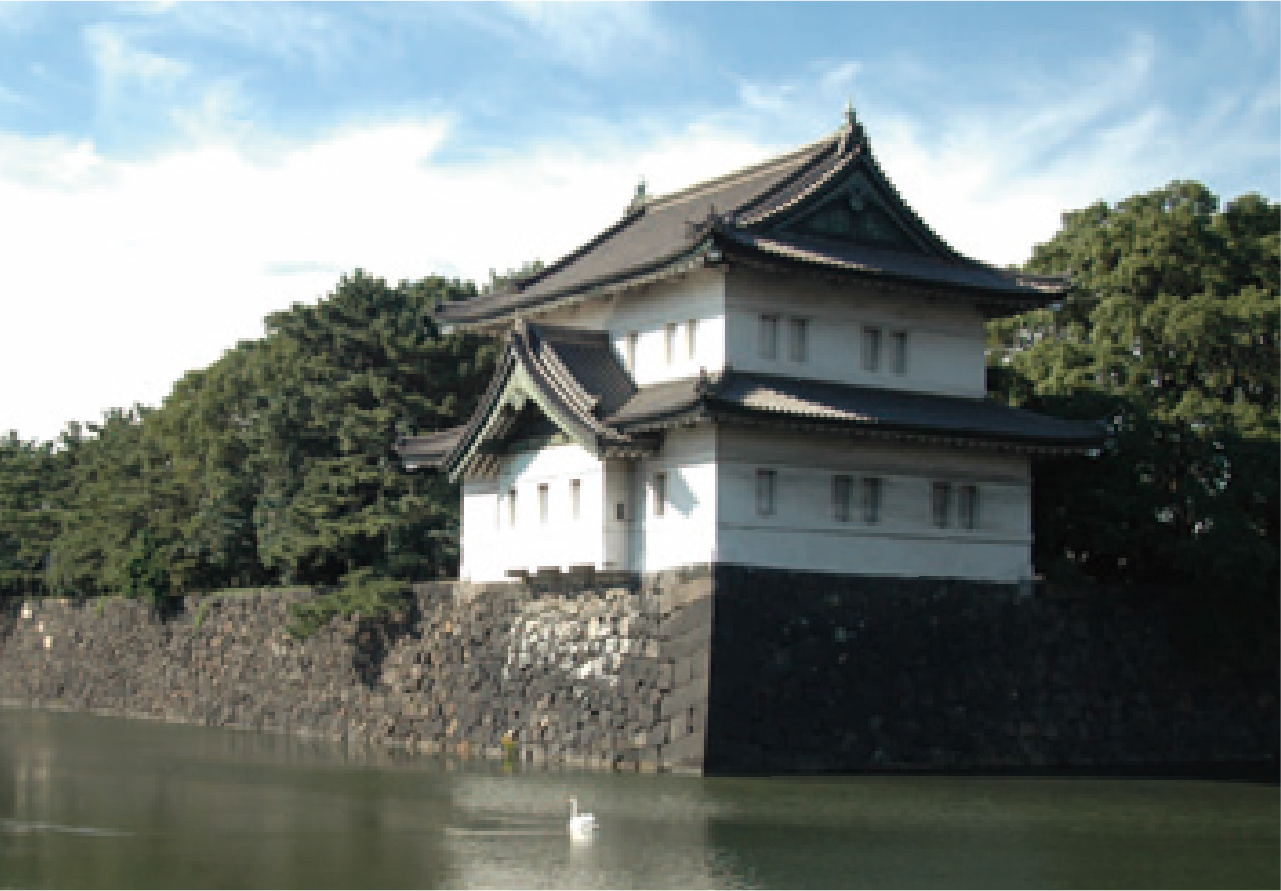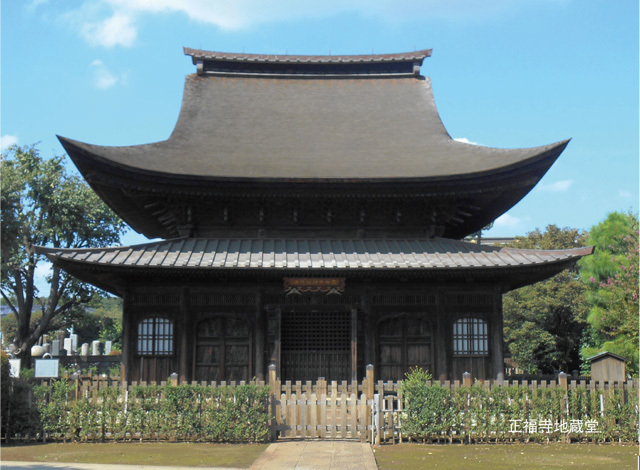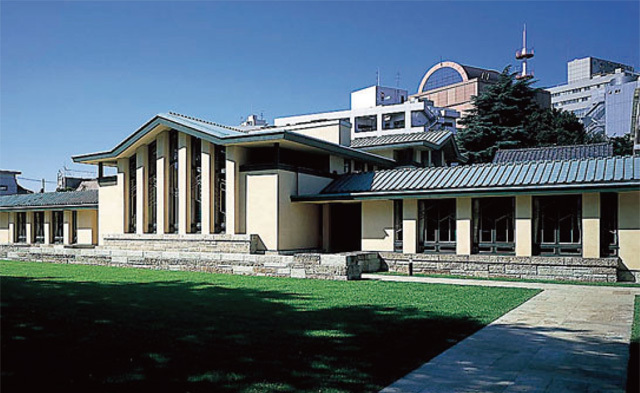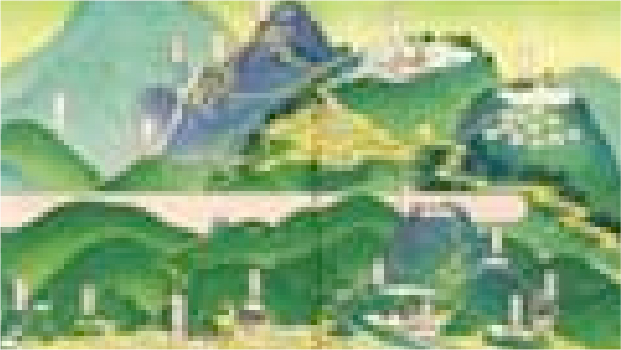
Let's take a stroll around Medieval Tama region
Medieval Tama region Course
Riding on JR Ome line, we can see the rural views with a lot of green from the window. In this region, local power of MITA Clan who had ruled here from the Kamakura period to the Warring States period, remained several traces at temples or castles around here. Since they claimed to be a descendant of TAIRA-no-Masakado, several legends related to Masakado has been handed down too.
This route introduces the historic sites that make us to experience the atmosphere of the Medieval history in Ome, Hamura and Akishima. Let’s discover another charm of historical Tama area with Cultural properties abound in nature green.
Let's take a stroll around Medieval Tama region (Ome, Hamura, Akishima)
Tama-gawa River that flows from Okutama, forms an alluvial fan at Ome and a flatland from Ome to Hamura-Akishima. In ancient times, as Kokufu (provincial capital) was placed at Fuchu, Tosan-do Musashi-michi Street heading to Kokubunji City and Fuchu City was built in Musashi Province. After the decline of the Kokufu, it remained principal route from North Kanto region to Kamakura. It was also known as the route that NITTA Yoshisada proceeded when he defeated Kamakura Shogunate.
Although Ome is out of this main route, it had been one of the important districts in Musashi Province, owing to Kamakura-kaido Highway from Chichibu passing through Ome to Fuchu or Kamakura, and Kasumigawa River leading to Iruma. As Musashi Province was adjacent to Sagami Province where Kamakura was located, it was owned by senior vassals of the Kamakura Shogunate. After the Muromachi period, this province was controlled by Kanto Kubo (the official in charge of the Kanto region), Kanto Kanrei (a shogun deputy for the Kanto region), and local lords.
Ome, Hamura and Akishima were controled by MITA Clan, local lord from the Kamakura to the Warring States period. They were described in well-known historical chronicles such as “Azumakagami” or “Taiheiki”.
According to the inscription on a temple bell of Tennei-ji Temple which was made in 1521, MITA Clan claimed that they were a descendant of TAIRA-no-Masakado. Taira-no-Masakado (?-940), a grandchild of Tairano-Takamochi (Emperor Kanmu’s great grandchild), raised a rebellion against the Imperial Court in 939 and named himself as “New Emperor”.
He had influenced in ancient history of Musashi Province. Since MITA Clan had controlled Tama region near Kamakura and claimed a descendant of TAIRA-no-Masakado who was a person in power of Kanto region of ancient times, it is supposed that they were one of the powerful local lords of the region at that time.
MITA Clan had controlled middle and upper stream area of Tamagawa River. While Odawara HOJO Clan’s army had invaded to South Musashi Province, MITA Clan was defeated at Karakai Castle, in the north of Kaizen-ji Temple (1559). So memorial graves for them have been at Kaizen-ji Temple. Many temples and castles that we introduce in this tour had belonged to MITA Clan, and folklores about the relation between TAIRA-no-Masakado and them has been handed down to the present. Let's stroll around MITA Clan’s estate in the Medieval period and see legends of temples.
What is more, Ome-kaido Highway, Itsukaichi-kaido Highway and Nariki-kaido Highway were well arranged in the Edo period, and this area had been developed with the production of timber, Ina stone, coal and charcoal.
How about come and see relevant remains of wealthy farmer family's residences?
Walking Course Highlights / Ome city
- Aoume of Kongo-ji Temple
- Main Gate of Kongo-ji Temple
- Main Hall of Kannon-ji Temple
- Nio-mon Gate of Kannon-ji Temple
- Amida-do Hall of Kannon-ji Temple
- Wooden Statues of Standing Kongo Rikishi
- Wooden Statues of Twenty-eight Attendants of Senju Kannon
- Big Cedar Tree of Shiofune Kannon
Walking Course Highlights / Hamura city
- Main Hall of Aso-jinja Shrine
- Castanopsis of Aso-jinja Shrine
Walking Course Highlights / Akishima city
- Wooden Statues of Standing Kongo Rikishi
- Wisteria of Haijima
- Precincts of Dainichi-do Hall and Hiyoshi-jinja Shrine
Route Map
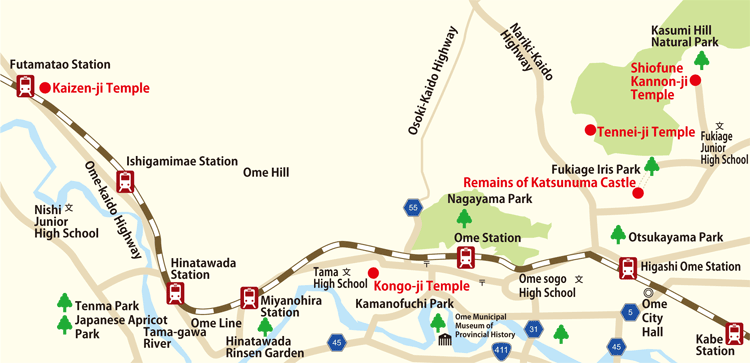

Brochure (PDF)
Ome city Course (Let's take a stroll around Medieval Tama region)
Precincts of Kaizen-ji Temple
It has been said that Zuiryu-zan Kaizen-ji Temple has its origin in a small cottage, Chosho-an that a priest Ekishi Eiken built during the Kansho era (1460-65). In the later years, the temple was patronated by MITA Clan, a local lord of this region and was called Chosho-zan Fukuzen-ji Temple. A group of memorial pagodas such as Hokyoin-to pagoda and Five-ring pagoda that enshrined MITA Clan’s ancestors remains in this temple precinct.
While MITA Clan had been opposed to Odawara HOJO Clan from 1565 to 1567, MITA Clan left Katsunuma Castle and moved into Karakai Castle on the ridge of Mt. Raiden behind this temple. When MITA Clan was destroyed by Odawara HOJO Clan, all the buildings in the precincts were destructed by fire caused by the soldiers under Odawara HOJO Clan. This temple was renamed to current name at the time of approval for ownership by TOKUGAWA Ieyasu in 1591.
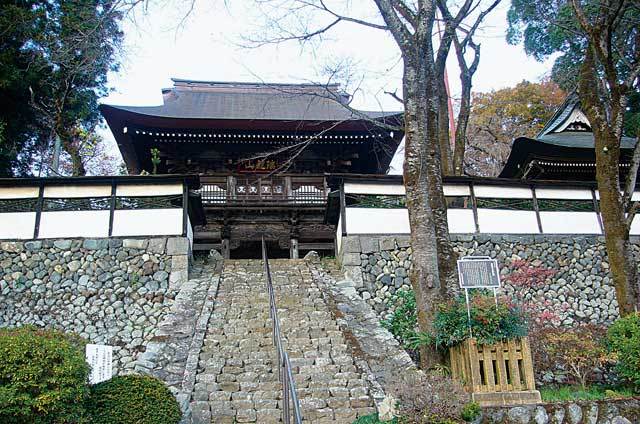
San-mon(Temple Gate) of Kaizen-ji Temple
At the precincts there are typical mountainous temple’s buildings of Zen Sect from the Edo period in Tama region, such as a So-mon Gate (designated for Cultural Property of Ome City) allegedly rebuilt in 1612, a San-mon Gate allegedly rebuilt in 1793.
At the opposite side of the Tama-gawa River, there is YOSHIKAWA Eiji House & Museum, who is known as writer of “Shin Heike Monogatari (New Tale of the Heike)”, and behind that, there is a Karakai Castle, where the MITA Clan ended.
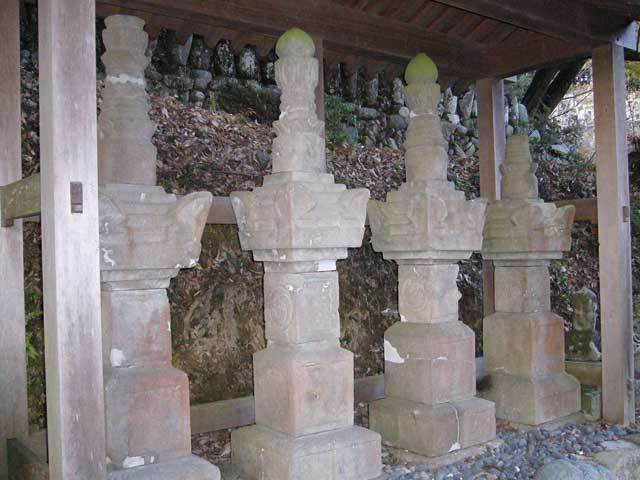
Memorial Pagoda for Mita Clan
Opening Information
- Open :
- All year
- Times :
- 6:00~16:00
- Fee :
- Free
Ome city Course (Let's take a stroll around Medieval Tama region)
Kongo-ji Temple
Aoume of Kongo-ji Temple
Natural Monument of Tokyo
Designated on June 1922
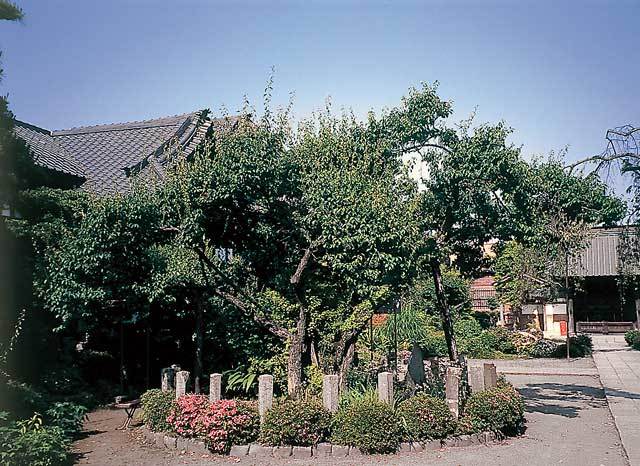
Ome of Kongo-ji Temple
In front of the Main Hall in precincts of Kongo-ji Temple, 750 meters west from Ome Station of JR line, there is a Japanese Apricot tree, called “Aoume (lit. green Japanese Apricot) of Kongo-ji Temple”.
According to the legend, TAIRA-no-Masakado stopped here to plant a branch of Japanese Apricot tree used as a rod for horse into the ground and said “If my dream comes true, it will be able to flourish, or not it must die”. And then, since the branch put down root and leaves grow thick, Masakado was willing to build a temple. It is said that this tree is exactly “Aoume of Kongo-ji Temple”.
Japanese Apricot is a deciduous broad-leaved tree of the family Rosaceae. It was introduced from China to Japan before the Nara period, have been widely planted. Although it’s fruits usually mature and drop, the fruits of this “Aoume” tree immature after summer. The name of City comes from this green Japanese Apricot of Kongo-ji Temple. This phenomenon of immature is a kind of mutation that rarely happens.
Main Gate of Kongo-ji Temple
Tangible Cultural Property (Buildings) of Tokyo
Designated on January 31 1961
Category changed on July 1 1976
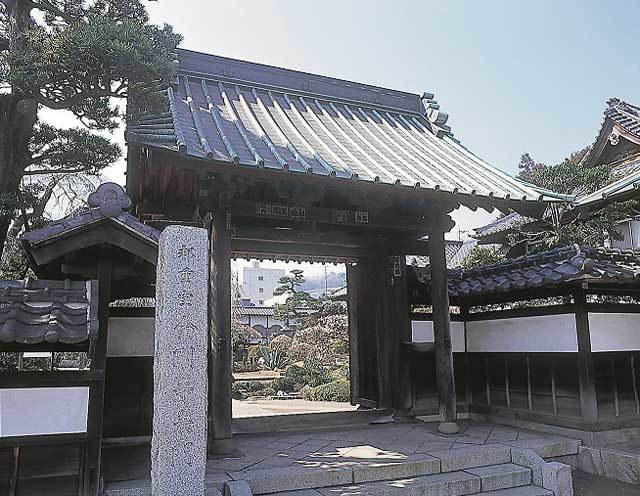
Main Gate of Kongo-ji Temple
According to a tradition, it has been handed down that Ome-san Muryoju-in Kongo-ji Temple was established by TAIRA-no-Masakado. The legend is as follows: TAIRA-no-Masakado plant a branch of Japanese Apricot into the ground and promised if this branch took root, he would build a temple. This temple was named for Henjo Kongo (alias of Kukai).
After MITA Clan who claimed a descendant of Masakado lost their power, this temple flourished with the support of Odawara HOJO Clan, and it was given the fief by TOKUGAWA Clan later. But in 1841, temple buildings were burned down except the Main Gate and a bell tower. The temple stores many cultural properties, such as “Painting of Nyoirin Kannon (Cintamani-cakva), color on silk” (Important Cultural Property (paintings)).
The gate was relocated to its current place due to a land readjustment in the early Meiji period. The gate has Yotsuashi-mon gate style with one entrance and a gable roof with copper sheets. The gate still keeps its original state.
There is Kaerumata (arched support shaped like the crotch of a frog) and a decoration called Eyo (carvings or paintings) on Kibana (nosing attached to the ends of tie beams) and Kobushibana (a kind of Kibana) at the gable. Judging from their style, the main gate is presumed to have been built in the early or the middle 17th century. For the small part, Zen Sect style was also adopted.
Opening Information
- Open :
- All year
- Times :
- 7:00~17:00
- Fee :
- Free
Ome city Course (Let's take a stroll around Medieval Tama region)
Precincts of Tennei-ji Temple
Takamine-san Tennei-ji Temple of Soto Sect was founded by a local load MITA Clan in the Bunki era (1501-1504) where has legend that it had been Shingon Sect Koho-ji Temple founded by TAIRA-no-Masakado. Katsunuma Castle which MITA Clan was based on was located in the southeast of the temple. According to a description in “Shinpen Musashi Fudokiko” (A Topography of Musashi Province, c. 1804-1829), it had been a great temple with property of 20-koku (Japanese unit of volume, rice 1-koku is approximately 180 liters) and 37 subordinate temples.
Many temple buildings from the Edo period remain in the precinct, which represent the layout of Zen Sect temple in the Medieval period.
Through So-mon Gate, earthen wall remain along the approach, and turning the left, via San-mon Gate and Chujaku-mon Gate, Main Hall (Hatto) appears. San-mon Gate was rebuilt in 1760, Chujaku-mon Gate in 1853 and Main Hall in 1707. Most of temple buildings had been thatched, but they are replaced with copper roofing.
At bell tower there is a temple bell with inscriptions indicating that MITA Masasada, who claimed a descendant of TAIRA-no-Masakado, donated it to the temple in 1521. This bell is designated for National Important Art Objects as a rare craft in Tokyo going back to the Medieval period.
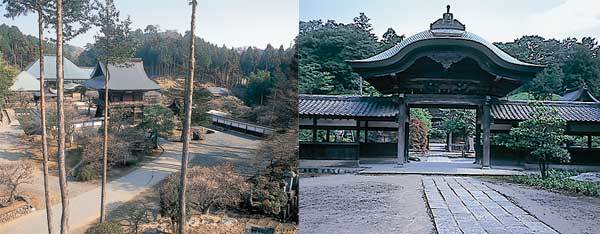
Precincts of Tennei-ji Temple
Opening Information
- Open :
- All year
- Times :
- 6:00~16:30 (until 17:00 in summer)
- Fee :
- Free
Ome city Course (Let's take a stroll around Medieval Tama region)
Remains of Katsunuma Castle
Powerful and wealthy families with significant local land holdings,MITA Clan who controled Ome region in the Medieval period,was based on Katsunuma Castle. This castle which was located on a hill overlooking Kasumi-gawa River was a typical medieval castle planed with a Karabori (a dry moat), Dorui (earthen walls for fortification) and Kuruwa (walls of a castle). There is Tennei-ji Temple which MITA Clan worshipped in the northwest of the castle.
MITA Clan who claimed a descendant of TAIRA-no-Masakado extended their influence in this region as a powerful lord since the Muromachi period. After the late Muromachi period, this area was on the border of sphere of influence of UESUGI Clan and HOJO Clan. When UESUGI Kenshin invaded into the Kanto region, MITA Clan that belonged to the army of UESUGI Clan, was destroyed by HOJO Clan.
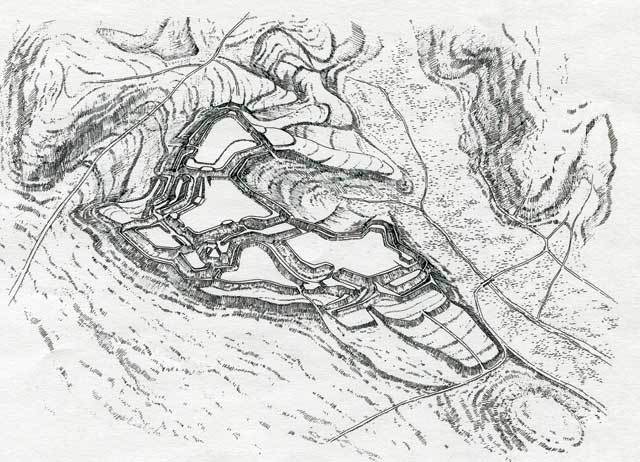
Birds-eye view reconstraction Map of Katsunuma Castle from the southeast.
According to a description in “Shinpen Musashi Fudokiko” (A Topography of Musashi Province, c. 1804-1829), after destruction of MITA Clan, MOROOKA Yamashiro-no-kami, a retainer of HOJO Clan, had lived here, so this castle has alternate name of MOROOKA Castle.
Around big three blocks aligned, remains including ditches and mounds are well preserved. Nowadays, this area is designated for Historic Conservation Area of Tokyo, and is protected its natural enviroment associated with historic heritage.
※ Good walkers only
Opening Information
- Open :
- All year
- Times :
- All day
- Fee :
- Free
Ome city Course (Let's take a stroll around Medieval Tama region)
Shiofune Kannon-ji Temple
Main Hall of Kannon-ji Temple
National Important Property (Buildings)
Designated on November 29 1946
Changed Name on February 13 1963
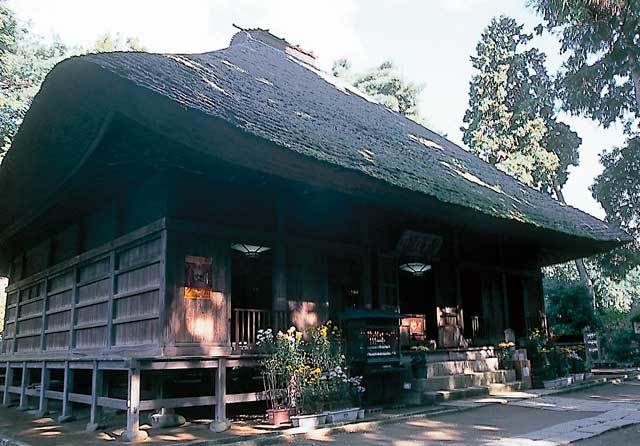
Main Hall of Kannon-ji Temple
Main Hall (Kannon-do Hall) of Shiofune Kannon stands on a levelig ground in the center of the hills.
Main hall is made in Yosemune-zukuri style, thatch roof, 5 ken (ken is the interval between two pillars) in both width and depth (about 12 square meters). The hall has simple exterior fenced in with board wall and wooden door, a board floor and a panel-lined ceiling. The hall is in the form of the Esoteric Buddhist hall with Naijin (inner sanctuary) and Gejin (outer place of worship for public) which are divided by latticedoor called “Kekkai (boundary)”. It is furnished with Raigoheki (wall) and Shumidan (timber altar) around Naijin. Kumimono (bracket complex composed of bracket arms and bearing blocks) on Raigobashira (circular pillars right and left at each corner of the Buddhist altar) is based on Wa-yo (Japanese style) adding Zenshu-yo (Zen Sect style). From this construction style and a decoration called Eyo (carvings or paintings) on Kibana (nosing attached to the ends of tie beams), the hall is presumed to be built in the late Muromachi period.
The design of Zushi (miniature shrine) on Shumidan is very outstanding. According to the inscription of the pedestal, the Senju Kannon (Thousand armed Avalokiteshwara) enshrined in this Zushi was repaired with the support of MITA Ujimune and his son Masasada in 1512.
Opening Information
- Open :
- All year
- Times :
- 8:00~17:00
- Fee :
- ¥100
Nio-mon Gate of Kannon-ji Temple
National Important Cultural Property (buildings)
Designated on November 29 1946
Changed Name on February 13 1963
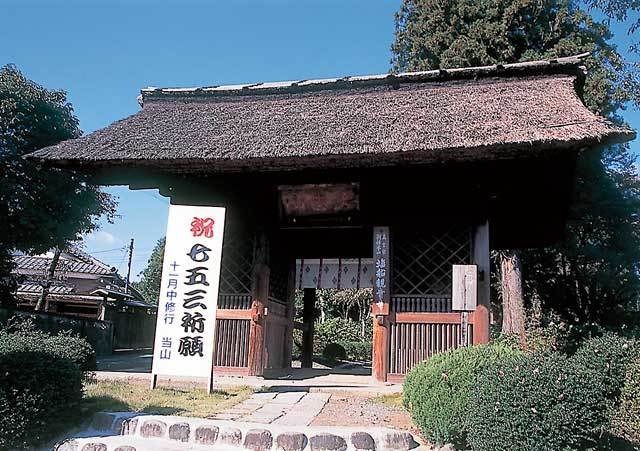
Nio-mon Gate of Kannon-ji Temple
Nio-mon Gate (Deva Gate), which is an entrance of Shiofune-Kannon, stands on the border between a flatland and a slope of Shiofune hill.
This gate of 6 meters in width and 3.6 meters in depth with the thatch roof has been built in Kirizuma-zukuri style (gable roof) of 3-ken (ken is the interval between two pillars) wide with one entrance and eight legs. There is a tablet of “Daihizan” hanged on the front top, and on both sides of the front two wooden standing statues of Kongo Rikishi (designated for Tangible Cultural Property (sculptures) of Tokyo) are enshrined. It was written in “Shinpen Musashi Fudokiko” (A Topography of Musashi Province, c. 1804-1829) that there was a wooden tablet indicating that these statues were created in 1184 but it no longer in existence.
From the comparison with design of Main Hall, it was estimated that this gate was built in the late Muromachi period.
Amida-do Hall of Kannon-ji Temple
National Important Cultural Property (buildings)
Designated on November 29 1946
Changed Name on February 13 1963
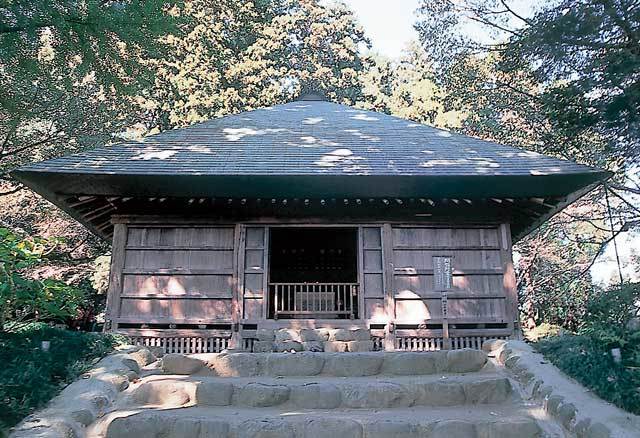
Amida-do Hall of Kannon-ji Temple
Amida-do Hall stands behind Nio-mon Gate (Deva Gate), which is an entrance of Shiofune Kannon-ji Temple.
The hall is made in Yosemune-zukuri style, copper sheet roofing in thatch roof style and has simple exterior with a board floor. It has Naijin (inner sanctuary) of 1-ken (the interval between two pillars) in width and 2-ken in depth surrounded with 1-ken hisashi (eaves), which is called “Amida-do style”. Naijin is surrounded by lattice-door at the half back of it. A decoration called Eyo (carvings or paintings) on Kibana (nosing attached to the ends of tie beams) is old-fashioned, but the construction style is presumed not to be older than the Main Hall. So Naijin are said to be built in the late Muromachi period.
The hall is considered to be an uncompleted building because the ceiling covers only Naijin without “en” (terrace). It might be related to the fall of MITA Clan around 1563.
Concerning to Amida-do Hall, it was written in “Shinpen Musashi Fudokiko” (A Topography of Musashi Province, c. 1804-1829) that there was a wooden tablet of 1610, and the inscriptions in 1641 was found from materials for lattice-door during repair work of 1962.
Wooden Statues of Standing Kongo Rikishi, Kannon-ji Temple
Tangible Cultural Property (sculptures) of Tokyo
Designated on April 1 1960
Changed Category on July 1 1976
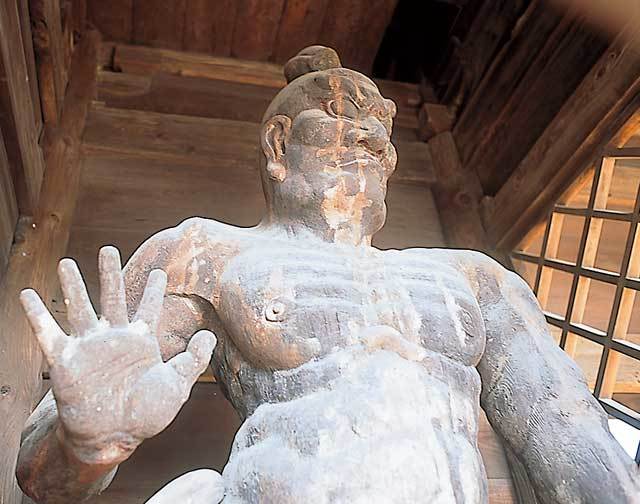
Ungyo, Wooden Statue of Standing Kongo Rikishi
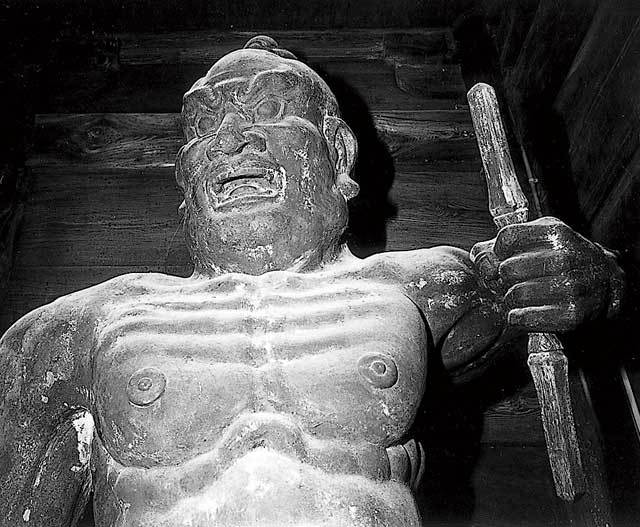
Agyo, Wooden Statue of Standing Kongo Rikishi
A pair of Kongo Rikishi is enshrined at either side of the Niomon Gate (Deva Gate) of the temple in order to protect Buddhism and the temple itself. These statues are made of joined blocks of Japanese cypress and are represented as muscular, threatening wrestler-like figures with their torsos bare. Agyo has his mouth open, wields a single-pointed vajra in the left hand, while his right arm is lowered with the palm down and the fingers splayed open. Ungyo has his mouth tightly closed, his left hand in a clenched fist and the right palm thrust forward with his fingers splayed open. Both bear an expression of rage, and scowl inside the gate to repel the evil spirits that fight against Buddhism.
According to the “Shinpen Musashi Fudokiko” (A Topography of Musashi Province, c. 1804-1829), there was once a tablet indicating that these statues were created in 1184. However, by comparing them with Wooden Statues of the Twenty-eight Attendants enshrined in the Main Hall, we find many common features such as their massiveness, facial expressions and the carved treatment of the clothing. Thus it is estimated that this pair of statues was most likely produced by Buddhist sculptors from the Teikai school in the late Kamakura period. The tablet bearing the repair record, which is designate as the appendix, tells us that the restoration work was done by Enkei, a Buddhist sculptor from Kamakura.
Wooden Statues of Twenty-eight Attendants of Senju Kannon
Tangible Cultural Property (sculptures) of Tokyo
Designated on May 6 1983
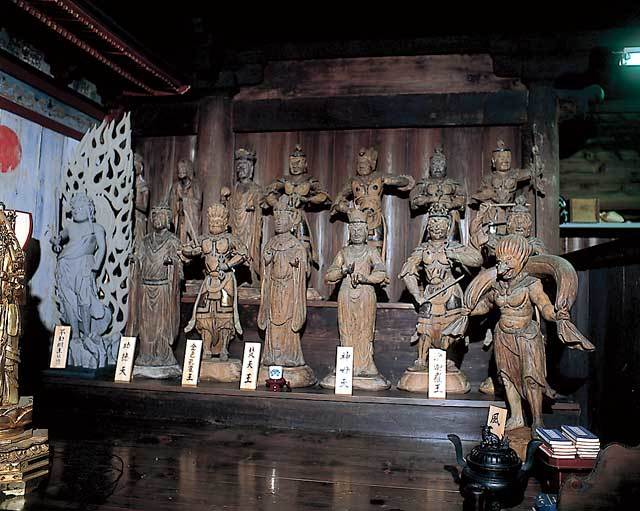
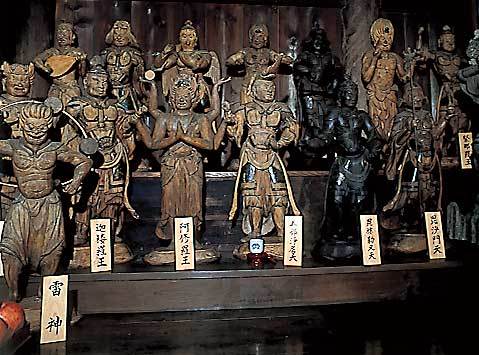
Wooden Statue of the Twenty-eight Attendants of Senju Kannon
On either side of the principal statue of the Senju Kannon (Thousand-armed Avalokiteshwar) , sculptures of the Twenty-eight Attendants are also enshrined to protect the Senju Kannon and its devotees. Most of the figures that are represented as dignitary, celestial maiden, military commander, fearful god, wrestler or beast, originated as demons and deities drawn from Brahmanism or Indian myth. In sculpture, extant examples of all twenty-eight figures are rare. The Kannon-ji example is the second oldest behind the well-known example of Rengeo-in Sanjusangen-do Temple in Kyoto.
All of the statues are made of Japanese cypress and crafted in the split-and-join method with applied color or gold foil on lacquer on the surface. Written inscriptions found within the statues indicate that these 23 figures were produced by Buddhist sculptors from the Teikai school from 1268 to 1288. Seven of them, including the figures of Gobujogo, Asura and Garuda, bear the signature of Teikai.
In the Eisei era (1504-1520) of the Muromachi period, these statues were repaired and five replacement statues were created by the sculptor Koen through the sponsorship of MITA Ujimune. While restoring the figure of Kudokuten in 1513, it was revealed that the statue had been created in memory of the son of KANEKO Juro, Kanaomaru, who had died young, and his hair was placed in a reliquary inside the head of Kudokuten. MITA Ujimune mourned over and inscribed a waka poem as a requiem for Kanaomaru on the back of the wooden tag inside the statue.
Big Cedar Trees of Shiofune Kannon
Designated for Natural Monument of Tokyo
Designated on November 3 1953
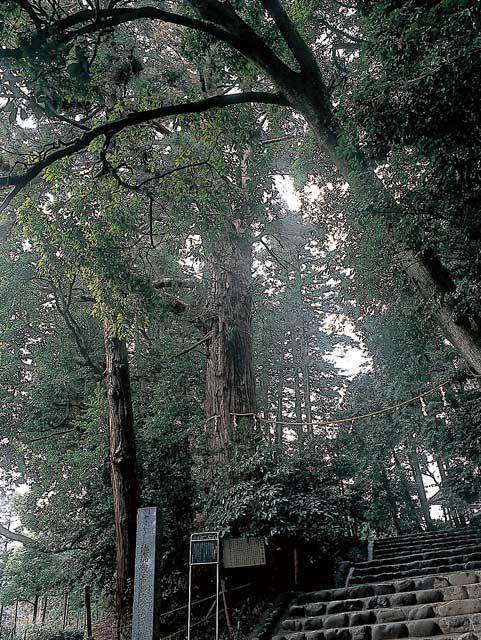
Big Cedar Trees of Shiofune Kannon
Daihi-zan Kannon-ji Temple is known also as a temple of flower. A pair of big cedar trees stand on the each side slope of the approach to Kannon-do (Main Hall). In the forest of Kannon-ji Temple with cedar and camphor trees, these cedar trees are called “Big Cedar Trees of Shiofune Kannon”, and also called “Cedar couple trees of Shiofune Kannon”.
The left cedar is about 43 meters in height and its trunk is about 5.7 meters in circumference. The right one is about 40 meters in height and its trunk is about 6.6 meters in circumference. These two are largest trees in Tokyo Metropolitan Area, and they are designated for natural monuments of Tokyo as same as Iimori Cedar of Mt. Takao and Three Cedars of Hikawa in Okutama Town.
Japanese cedar is a kind of tall evergreen trees which grows in Honshu, Shikoku and Kyushu (until Yakushima Island), mainly Pacific coast in Japan. Japanese cedar is used in various situations, such as construction materials or daily needs and planted as sacred tree in precincts of shrines. It is one of the familiar trees for Japanese.
Column (Let’s take a stroll at Shiofune Kannon)
Kannon-ji Temple which is named Shingon Sect Daigo school Daihi-zan, is affectionately called as Shiofune Kannon-ji Temple.
According to Engi (the origins of the temple) of 1751, this temple started when Happyaku-bikuni (Buddhist num) came from Wakasa (current Fukui prefecture) to Kanto region and enshrined Senju Kannon (Thousand Armed Avalokiteshwara) of 5.4 centimeters here. Happyaku-bikuni is a legendary nun who had lived 800 years because she ate mermaid. It was written in an article of “Gaun Nikkenroku” (diary of Shokoku-ji Temple’s monk Zuikei Shuho) that she appeared at Kyoto in 1449.
In the Tenpyo era (729-748) a monk Gyoki (?-749) rebuilt the ruined buildings of temple, and he named here Shiofune because the scape looks like a ship. It is said that Annen, a monk came from Hiei-zan, rebuilt Kannon-do Hall (Main Hall), built Amida-do Hall and Yakushi-do Hall, established 12 Tatchu (Subtemples) and fundraised for Shichisha-Gongen, so the fortunes of the temple were flourished.
On a slope of Shiofune hill, Main Hall, Amida-do Hall, Nio-mon Gate (Deva Gate) (Natural Important Cultural Property (Buildings)), Sanno-Shichisha-Gongen, Yakushi-do Hall and bell tower still stood here systematically. Today, this temple is popular with azalea festival in spring, hydrangea in summer and bushclover in autumn.
Opening Information
- Open :
- All year
- Times :
- 8:00~17:00
- Fee :
- Free
Hamura city Course (Let's take a stroll around Medieval Tama region)
Aso-jinja Shrine
Main Hall of Aso-jinja Shrine
Tangible Cultural Property (Buildings) of Tokyo
Designated on March 31 1966
Changed Category on July 1 1976
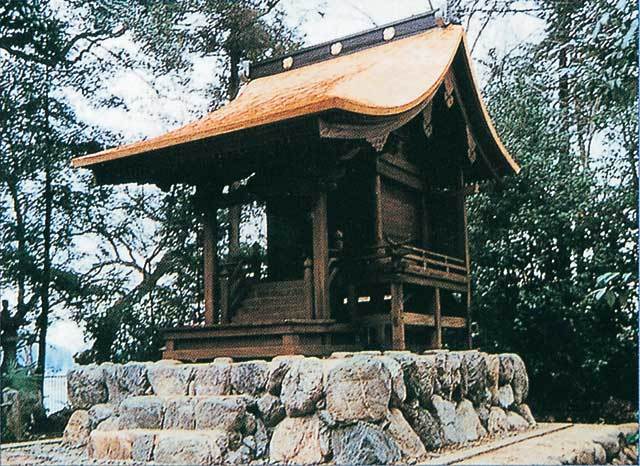
Main Hall of Aso-jinja Shrine
Main Hall (Kannon-do Hall) of Shiofune Kannon stands on a levelig ground in the center of the hills.
The West part of Hamura City has beautiful landscape along Tamagawa River. According to the history of Aso-jinja Shrine at Hanekami, Aso Daimyojin appeared from Higo Province (current Kumamoto prefecture) to quell flooding of the river. It is also said that the shrine was constructed by TAIRA-no-Masakado or by FUJIWARA-no-Hidesato who defeated Masakado. After that it was supported by HOJO Clan and MITA Clan. On the ridge tags (pertinent information regarding a building’s repairs or reconstruction is written with brush and ink), it was written that MITA Sadashige sponsored the repair of the shrine building in1536.
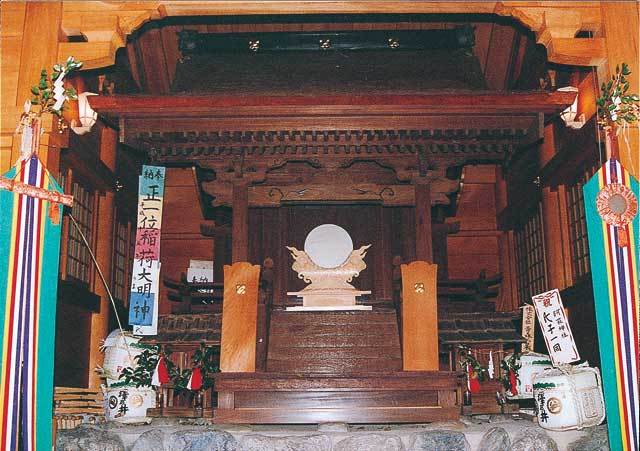
Main Hall of Aso-jinja Shrine (inside)
The current Main Hall was reconstructed with the donation of village people in 1676. It is Ikkensha nagare-zukuri style (a style of main shrine building that has a small one-bay sanctuary) with a gable roof. One side of the roof is gently curved and extended to form a step canopy, width of 1.45 meters at the beam, height of 4 meters. Although there are not many decorations, curves of Koryo (a moderately carved beam like a rainbow) are elegant. The sculpture of Kaerumata (arched support shaped like the crotch of frog) is older than building, so it is possible to have belonged older building. From the bottom of pillar, two carpenters’ name, ONO Ichiroemon and Taroemon are found. With the definite date of the shrine’s construction, this is also considered valuable as a reference of Shrine construction in this area.
Castanopsis of Aso-jinja Shrine
Designated for Natural Monument of Tokyo
Designated on January 29 1931
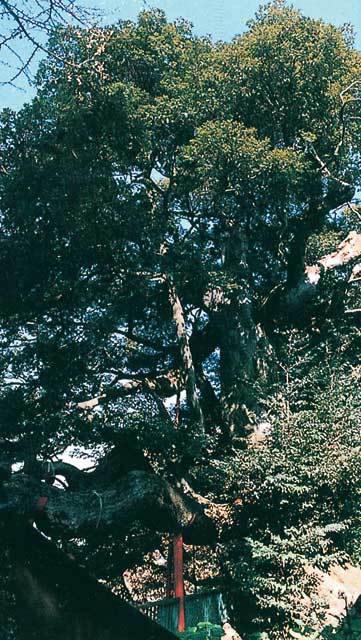
Castanopsis of Aso-jinja Shrine
Aso-jinja Shrine stands on the left bank of Tama-gawa River, Hanekami, Hamura City. A large castanopsis tree which is the sacred tree of the shrine stands on the precincts facing Tama-gawa River.
It has been said that Aso-jinja Shrine was first established by Empress Suiko in 601, and later TAIRA-no-Masakado built the shrine building, and FUJIWARA-no-Hidesato who defeated Masakado rebuilt it in 940 to give repose to Masakado’s vengeful spirit. It is said that Hidesato planted this Castanopsis at that time.
The tree is said to be over 1,000 years old. Its large branch was broken off by the typhoon in 1966, and its trunk is becoming hollow. However the tree whose height of 18 meters and trunk circumference of 6.2 meters, its branch still widely overhanging the bank of the Tama-river.
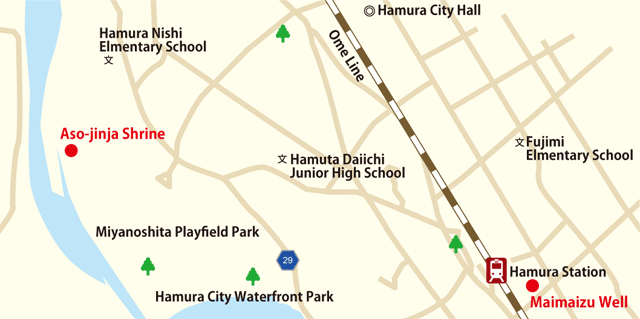
Opening Information
- Open :
- All year
- Times :
- 9:00~16:00
- Fee :
- Free
Hamura city Course (Let's take a stroll around Medieval Tama region)
Maimaizu Well
On Musashino plateau, it was necessary to dig deep down crumbly layer for getting water, because underground water flows deep under the ground. Before the mid Edo period, digging well vertically was very difficult and thus the method of Maimaizu Well was invented.
This well has been called Maimaizu Well, because the form looks like Maimai (snail in the vernacular). The ground was deeply dug in a mortar shape, and a shallow well was sunk straight down from the center of the bottom. The spiral path on the slope towards the well looks like a spiral of snail.
The well has a diameter of about 1 meter and of a depth of about 7.4 meters and is dug in the center of a pit having a shape of inverted cone, of a diameter of about 16 meters at a ground level, about 4 meters at the bottom and of a depth of about 5.5 meters.
As there is a record which shows that monumental plaques in the Kamakura or Muromachi period were excavated from the area around the well, its installation possibly dates back to the Medieval period. It is supposed that the well served as a central facility for the village, together with the adjacent Kumano-jinja Shrine (today’s Gono-jinja Shrine).
Many wells in similar structure including Big well of Ome-Shinmachi are found in Tama region, as well as in Hachijo-jima Island (Metto well).
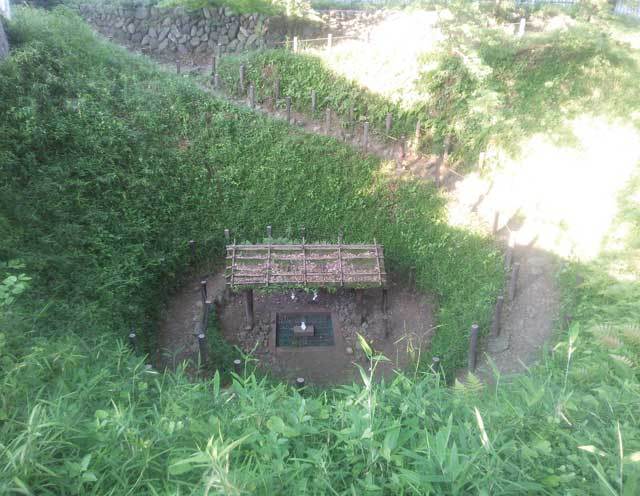
Maimaizu Well
Opening Information
- Open :
- All year
- Times :
- All day
- Fee :
- Free
Akishima city Course (Let's take a stroll around Medieval Tama region)
Dainichi-do Hall and Hiyoshi-jinja Shrine
Wooden Statues of Standing Kongo Rikishi, Fumyo-ji Temple
Tangible Cultural Property (sculptures) of Tokyo
Designated on April 28 1964
Changed Category on July 1 on 1976
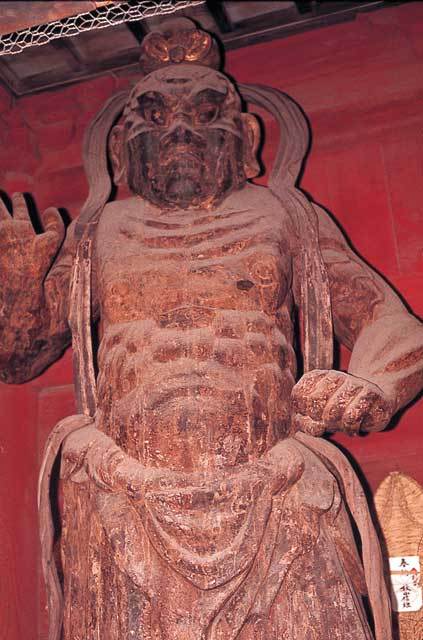
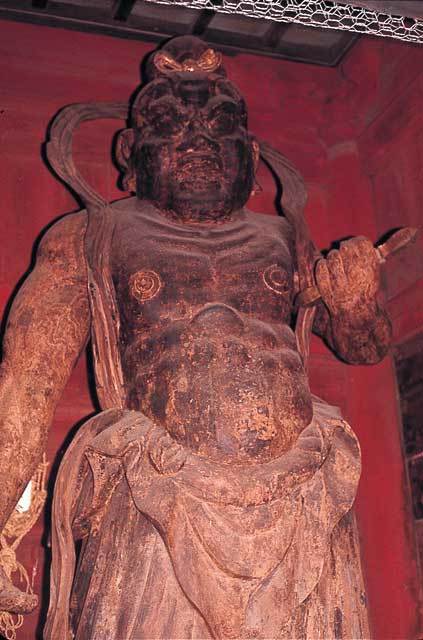
Wooden Statues of Standing Kongo Rikishi
Two statues of Kongo Rikishi are enshrined at a Nio-mon Gate (Deva Gate) of the temple. The two guardians represents the figures of Agyo, with his mouth open and an expression full of anger, and Ungyo, with his mouth tightly closed in an expression of hiding his anger inwardly. As ‘A’ is the sound of the first letter and ‘Un’ is the sound of the last letter of the Sanskrit alphabet, they symbolize the beginning and the end of the universe, or aspiration for Buddha-hood and attained nirvana.
Although these statues were attributed to the work of Unkei based on the record of the “Shinpen Musashi Fudokiko” (A Topography of the Musashi Province, c. 1804-1829), inscriptions bearing a date and name of the sculptor was found inside the statues when they were dismantled for repair in 1975-1977. It reveals that Agyo was made by the Buddhist sculptor Hizenbo in 1315 and Ungyo was made by the Buddhist sculptor Bizen□, sponsored by Yaji Magosaburo SUGAWARA Shigemitsu, who was a manor lord and vassal of the Kamakura Shogunate. Moreover, the inscriptions reading “Keihaku Jodo-ji” prove that a temple called Jodo-ji existed in this area during the Kamakura period.
The facial expressions of the statues are relatively gentle compared with other examples of Kongo Rikishi made during the Kamakura period, rather suggesting the aesthetic of the Heian period. The statues are valuable as surviving examples from the former Musashi Province.
Wisteria of Haijima
Natural Monument of Tokyo
Designated on Augast 21 1956
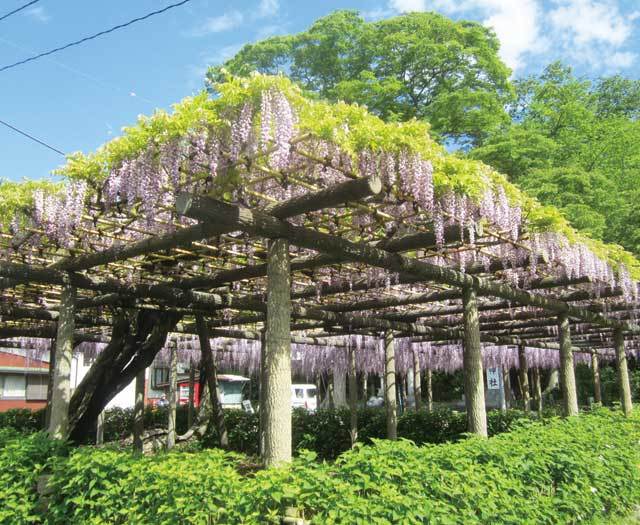
Wisteria in Haijima
There are big Fujidana (wisteria trellis) of 300 square meters at a corner of Haijima Park that spread on the flatland in front of Dainichido Hall, 1 chome Haijimacho, Akishima City. This is called “Wisteria of Haijima”.
Wisteria, belonging to the Fabaceae family, is low, woody, decidious and climbing plant. They grow in mountainous areas of the west and the center of the Honshu and also cultivated in the gardens for appreciation. Wisteria of Haijima, also called “Wisteria of Chitose” (1,000 years old Wisteria), is considered to have grown naturally in this precincts of Meio-in Temple since the end of Muromachi period. The temple was closed at the end of Edo period and only this wisteria has survived until now.
It is one of the biggest wisterias in Tokyo and is assumed to be about 800 years old. In spite of reduced vitality of the tree, it blooms beautifully with violet butterfly-shaped flowers in spring. Excellent clusters of 1 meter in length delight the eyes of visitors from in and out of Akishima City.
Precincts of Dainichi-do Hall and Hiyoshi-jinja Shrine
Historic Place of Tokyo
Designated on March 30 1992
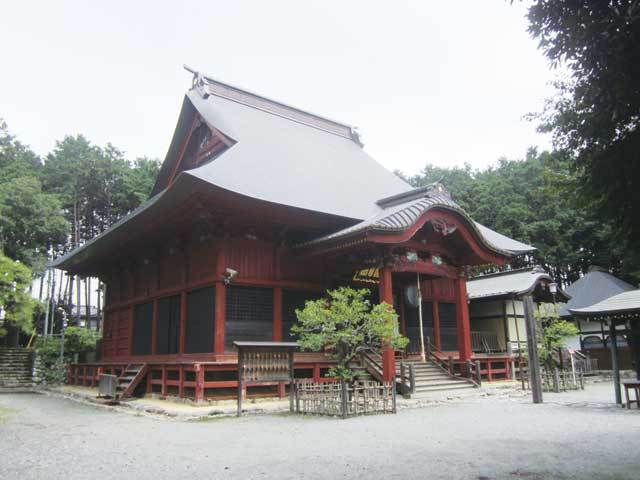
Dainichi-do Hall
The precincts formed with Dainichi-do Hall and Hiyoshi-jinja Shrine, a guardian shrine for the Tendai Sect, are situated along Nikko-kaido Highway which connected Hachioji to Nikko in the Edo period. A typical site for Tendai Sect with temple and guardian shrine is well preserved, and this is a rare example in Tokyo.
In the precincts, the Nio-mon Gate (Deva Gate) facing south stands on the south lowland, Dainichi-do Hall stands on the north, Yakushi-do Hall stands on the east, bell tower stands on the east-south and Hiyoshijinja Shrine stands in the west on the upland.
The Dainichi-do Hall, dedicated to Dainichi-Nyorai (Mahavairocana), was rebuilt in 1732. This building was a Goken-do Hall (a Buddha statue hall with a five bay long facade) in hip-and-gable roof style, with copper roofing that originally were thatched-roofed. It was designated for Tangible Cultural Property of Akishima City together with Nio-mon Gate. Yakushi-do Hall was built in the early Edo period though it seems to be repaired, and bell tower was built in 1796.
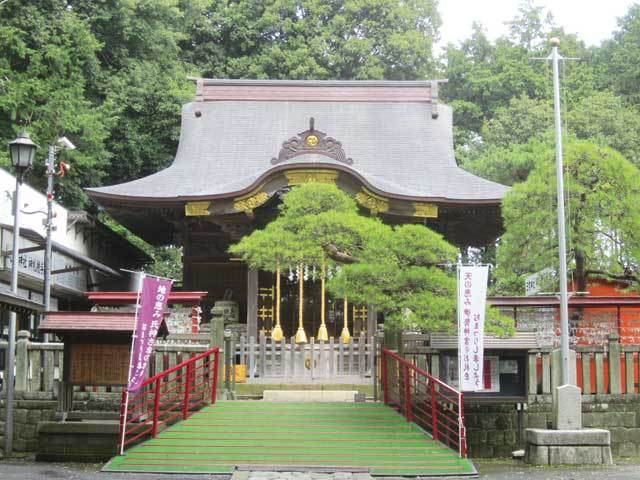
Hiyoshi-jinja Shrine
Among current buildings of Hiyoshi-jinja Shrine, Main Hall was built in 1844, Worship Hall and Votive-offering Hall were in 1855. Behind Worship Hall of hip-and-gable roof style, there are Main Hall of Ikkensha-nagare-zukuri (a style of main shrine building that has a small one-bay sanctuary) seen beyond Votive-offering Hall. Nowadays all halls have cooper roofing. Exterior walls of Main Hall decorated with gorgeously colored sculpture, splendid ceiling picture and picture plate in Worship Hall and painting on cedar-board doors in Votive-offering Hall are designated for Tangible Cultural Property of Akishima City.
Column (Walking around Dainichi-do Hall)
Dainichi-do Hall was once named Haijima-san Mitsugon Jodo-ji Temple. According to the temple legend, this temple was established when Dainichi-Nyorai (Mahavairocana) was drifted to a sandbank of Tama-gawa River by massive flood in 952. This temple was moved to the current site for the protection of Takiyama Castle (current Takatsukimachi Town, Kazumimachi Town, Tankimachi Town, Hachioji City) to guard against devils’intrusion from northeastern direction. The temple buildings were reconstructed by ISHIKAWA Tosa-no-kami, the lord of Takiyama Castle, an entrusted vassal of HOJO Ujiteru, who prayed for the cure of his daughter’s eye-disease.
The temple title “Jodo-ji” was lost during the Edo period. When Dainichi-do Hall was rebuilt in 1732, temple buildings were rearranged in current plan and belonged to Fumyo-ji Temple, one of “Dainichi Hachibo” (Eight Sub-Temples around Dainichi-do). It has been unknown when Hiyoshi-jinja Shrine was founded, but the shrine was considered to be built as a guardian shrine, Sanno Daigongen (manifestation of Dainichi Nyorai) in the Tensho era (1573-1593). After the Meiji Restoration, Dainichi-do temple halls of Tendai Sect and Hiyoshi-jinja Shrine, the guardian shrine for Tendai Sect, were separated due to the policy of the separation of Shinto and Buddhism but remain at the same place.
There are principal temple and shrine buildings (Dainichido Hall, Yakushi-do Hall, Worship Hall and Main Hall of Hiyoshijinja Shrine) on the upland of fluvial terrace of Tama-gawa River, and Nio-mon Gate, a Well, wisteria-pergola (Natural Monument of Tokyo) on lowland. Let’s enjoy visiting temples and others including Fujizuka Mound on the west of Hiyoshi-jinja Shrine, Buddhist sculptures enshrined, and sacred cedar grove of the shrine.
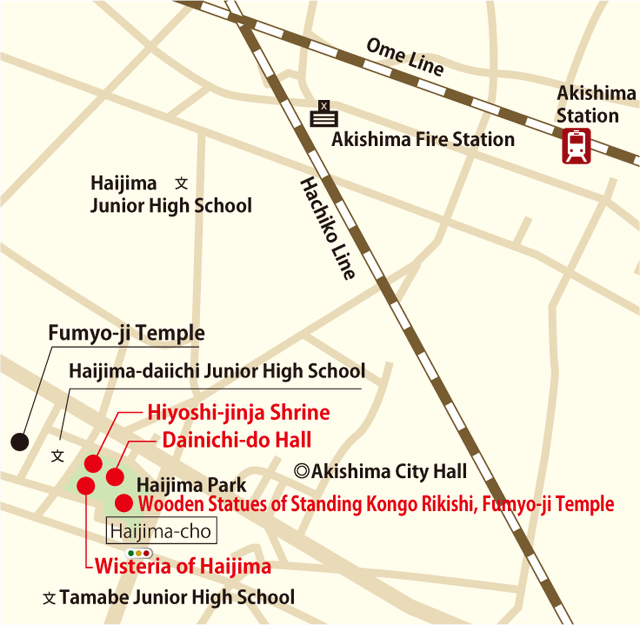
Opening Information
- Open :
- All year
- Times :
- All day
- Fee :
- Free
Tokyo Cultural Heritage Map
Would you like to go around cultural heritages? In Tokyo, there are various cultural heritages. This map helps you go around cultural heritages with efficiency during limited time in your trip. Japanese traditional temples and shrines, the cultural heritages concerned to most famous events and person in Japan and a lot of nature. This map introduces all of them widely! You must watch them and know the history and the culture of Tokyo!

SNS




